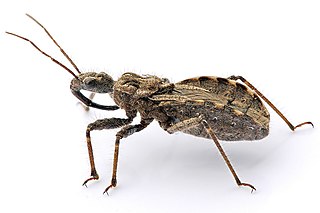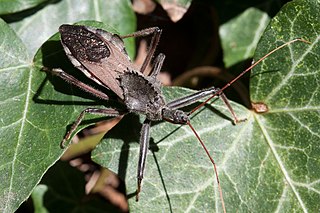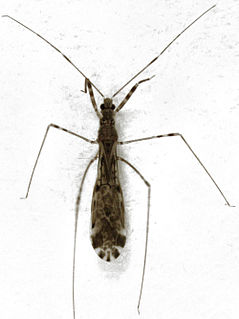| Austrokatanga monteithi | |
|---|---|
| Scientific classification | |
| Kingdom: | Animalia |
| Phylum: | Arthropoda |
| Class: | Insecta |
| Order: | Hemiptera |
| Suborder: | Heteroptera |
| Superfamily: | Cimicomorpha |
| Family: | Reduviidae |
| Subfamily: | Ectrichodiinae |
| Genus: | Austrokatanga Weirauch, 2009 |
| Species: | A. monteithi |
| Binomial name | |
| Austrokatanga monteithi Weirauch, 2009 | |
Austrokatanga monteithi is species of assassin bug, the sole member of its genus, in the subfamily Ectrichodiinae of Reduviidae. This species is found in Australia. [1]

The Ectrichodiinae are a subfamily of assassin bugs (Reduviidae) known for specializing on millipedes as prey. The group comprises more than 600 species in about 115 genera, making it a fairly large subfamily. The bugs are also known for their aposematic coloration, often brightly colored metallic blue, red, or yellow.

The Reduviidae are a large cosmopolitan family of the order Hemiptera. They can be perceived as slightly unusual, but they are very common among the Hemiptera because almost all are terrestrial ambush predators. The main examples of nonpredatory Reduviidae are some blood-sucking ectoparasites in the subfamily Triatominae. Though spectacular exceptions are known, most members of the family are fairly easily recognizable; they have a relatively narrow neck, sturdy build, and formidable curved proboscis. Large specimens should be handled with caution, if at all, because they sometimes defend themselves with a very painful stab from the proboscis.

Australia, officially the Commonwealth of Australia, is a sovereign country comprising the mainland of the Australian continent, the island of Tasmania and numerous smaller islands. It is the largest country in Oceania and the world's sixth-largest country by total area. The neighbouring countries are Papua New Guinea, Indonesia and East Timor to the north; the Solomon Islands and Vanuatu to the north-east; and New Zealand to the south-east. The population of 25 million is highly urbanised and heavily concentrated on the eastern seaboard. Australia's capital is Canberra, and its largest city is Sydney. The country's other major metropolitan areas are Melbourne, Brisbane, Perth and Adelaide.






